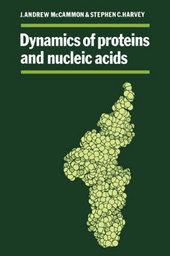
|
Dynamics of Proteins and Nucleic Acids
Paperback / softback
Main Details
| Title |
Dynamics of Proteins and Nucleic Acids
|
| Authors and Contributors |
By (author) J. Andrew McCammon
|
|
By (author) Stephen C. Harvey
|
| Physical Properties |
| Format:Paperback / softback | | Pages:248 | | Dimensions(mm): Height 229,Width 152 |
|
| Category/Genre | Biotechnology |
|---|
| ISBN/Barcode |
9780521356527
|
| Classifications | Dewey:574.19245 |
|---|
| Audience | | Professional & Vocational | |
|---|
| Illustrations |
Worked examples or Exercises
|
|
Publishing Details |
| Publisher |
Cambridge University Press
|
| Imprint |
Cambridge University Press
|
| Publication Date |
29 April 1988 |
| Publication Country |
United Kingdom
|
Description
This book is a self-contained introduction to the theory of atomic motion in proteins and nucleic acids. An understanding of such motion is essential because it plays a crucially important role in biological activity. The authors, both of whom are well known for their work in this field, describe in detail the major theoretical methods that are likely to be useful in the computer-aided design of drugs, enzymes and other molecules. A variety of theoretical and experimental studies is described and these are critically analyzed to provide a comprehensive picture of dynamic aspects of biomolecular structure and function. The book will be of interest to graduate students and research workers in structural biochemistry (X-ray diffraction and NMR), theoretical chemistry (liquids and polymers), biophysics, enzymology, molecular biology, pharmaceutical chemistry, genetic engineering and biotechnology.
Reviews'McCammon and Harvey's account is easily read and at the same time rewarding to those seeking deeper insight. With its comprehensive and well-balanced list of references, and its review of all the main developments, it will be an invaluable companion to those interested in the dynamics of biological macromolecules.' Nature 'This book will undoubtedly serve as a generally good introductory text for expert and non-expert alike.' Times Higher Education Supplement
|